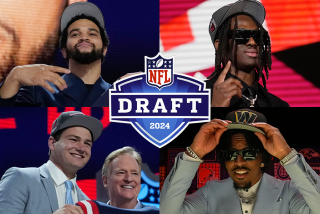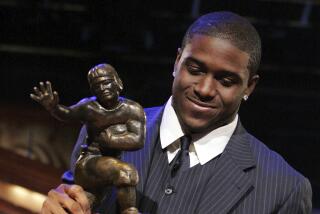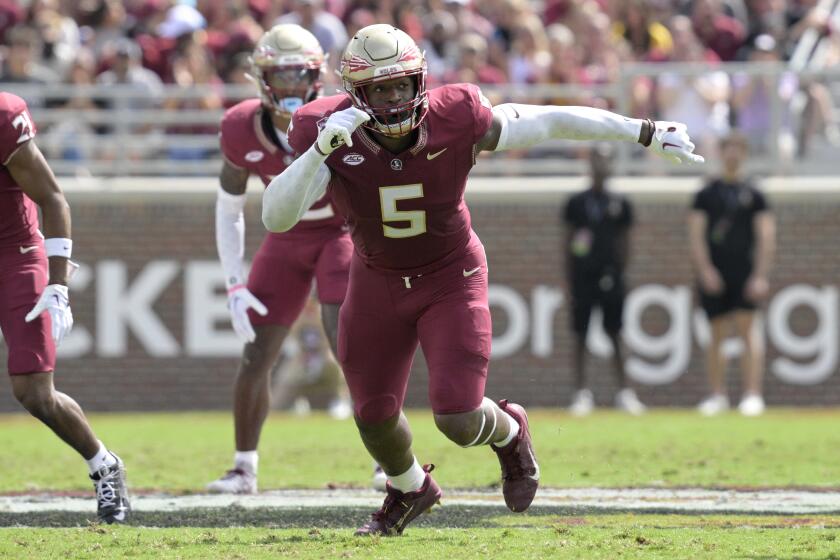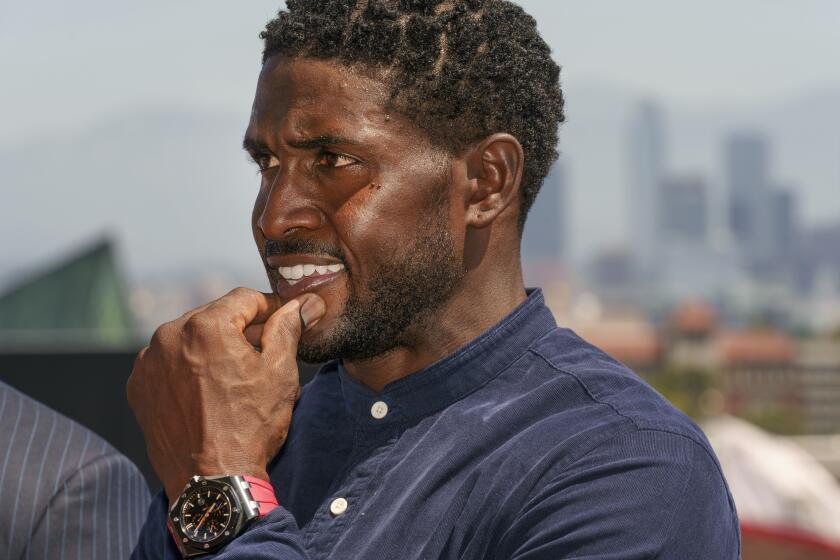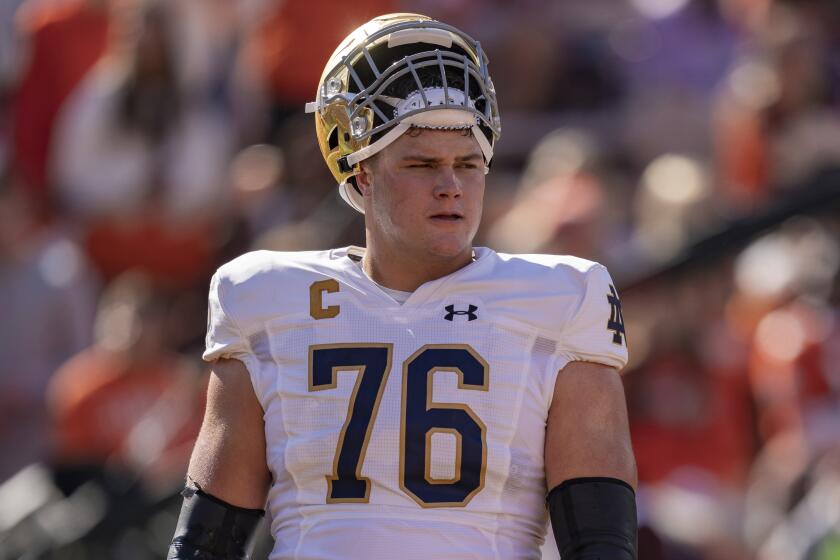BILLS, BILLS, BILLS . . .
Chad Billingsley rarely speaks above a whisper in the best of times.
And clearly these are not the best of times.
Through the first 2 1/2 months of the season, the Dodgers right-hander was arguably the best pitcher in the National League, going 9-3 with a 2.72 earned-run average to earn a spot on the All-Star team.
In the three months since, he hasn’t even been the best pitcher on his team, going 3-7 with a 5.40 ERA.
“I’m just trying to go out there and work on things,” Billingsley says quietly, speaking to his shoes as he ties the laces. “Figure something out.”
He’s not alone. Because while it’s clear something’s wrong with Billingsley, no one seems sure what it is.
Says Rick Honeycutt, his pitching coach: “He’s just missing a little bit. He still, at times, looks the same.”
Says Joe Torre, his manager: “He’s just rushing himself.”
But perhaps the best explanation comes from teammate Randy Wolf, who has the locker next to Billingsley’s.
“Things,” Wolf says, “happen weird in a season.”
Of course, spotting weird is a lot easier than curing it. Especially when there are at least three prevailing theories for what has caused Billingsley’s year to go weird.
It’s physical: Billingsley was pitching well in his first two August starts, but he had to leave early both times, the first because of a cramping right hamstring and the second because of a strained left hamstring. He missed one start and came back to beat St. Louis, but has gone 0-4 with a 5.96 ERA since.
“The one thing that can really affect guys is a leg problem,” Wolf says. “His hamstring bothered him and he wanted to get back out there in a hurry. Subconsciously, without even knowing it, a guy will pull back a little bit, maybe shorten his stride.
“I think that’s probably the biggest thing.”
It’s mental: Billingsley himself is leaning toward this diagnosis, saying it’s becoming harder and harder to let each poor performance go.
“I don’t think he’s got the same swagger that he’s had before,” says one National League scout, who is prohibited by his club from speaking about opposing players on the record. “I’ve heard the [hamstring]. I’ve heard when the foot lands one way it does this. There’s a lot of theories there.
“I think it’s confidence.”
It’s just bad luck: Since mid-June, Billingsley’s walks and strikeouts are way down, which means more balls are being put into play. Unfortunately for him, few of those balls are being turned into outs, with opponents hitting better than .330 against him on balls in play since early July.
But if the Dodgers aren’t fielding for their former ace, they aren’t hitting for him either. The team has lost four of Billingsley’s last five starts, scoring a total of six runs combined in those games.
“If you really look at the majority of those games during this time, a few runs here or there might have cured a lot of things [to] where nobody would be talking about this,” Honeycutt says.
Add it all together and, well, “it’s complicated,” says Dodgers trainer Stan Conte. “It’s all mixed up. It’s a tough one.”
Which is why Conte is not ruling anything out. Both hamstrings, he says, have been double- and triple-checked. But that doesn’t mean they’re not the problem.
“To say the hamstring has nothing to do with his performance, we can’t say that,” Conte concedes. “When someone says, ‘Is his hamstring OK?’ the answer is yes, it is OK. Is it affecting his pitching? There’s no way for us to know that.
“The performance is not what Chad would want. Is the hamstring a factor? I don’t know how it can’t be.”
And it takes just the slightest of changes to throw off a pitcher’s command, the one thing everyone agrees has been a problem for Billingsley. Although the velocity of his fastball has remained consistently in the mid-90s and he has been able to throw strikes, that doesn’t mean he’s putting the ball where he wants it -- or getting it to move as it should.
“He’s been leaving balls a little higher in the zone than he should,” says Russell Martin, who has been Billingsley’s regular catcher since the Dodgers drafted the pitcher with their first-round pick in 2003. “He’s staying in the middle part of the zone instead of working either up or down.”
Down the hallway in the visitors’ clubhouse at Dodger Stadium, Giants pitcher Barry Zito sits in front of his locker trading barbs with youthful teammate Tim Lincecum, who is 25 but looks about half that age.
Zito, a Cy Young Award winner, went through his own well-chronicled meltdown in 2007 and says coping with failure can be difficult for a young pitcher such as Billingsley, who is six weeks younger than Lincecum and, like the Giants ace, has never had a losing season as a pro.
“After this kind of ascension to the big leagues, most of us do deal with failure for the first time in the big leagues. Which is a lot harder to do,” Zito says. “We all get kicked in the [rear] in this game. Most of the time when we do struggle we don’t allow the game to just play on. We feel like we have to control every little aspect, every result.
“You basically just lose focus on what you can control. You start focusing on all the things you can’t control.”
Billingsley is running short on time to regain that focus. Torre skipped him last time through the rotation, sending him to the bullpen in the hope that a short but solid outing would help rebuild his confidence. That plan backfired when Billingsley was cuffed around for two runs and four hits in 1 2/3 innings Friday night, leaving to a smattering of boos from the fickle Dodger Stadium faithful.
He is scheduled to start again Wednesday against woeful Washington and will have two more opportunities after that to prove the Dodgers have a better shot at winning in the playoffs with him on the mound than with Vicente Padilla, Jon Garland or Clayton Kershaw. And until that’s settled, Torre says, the Dodgers’ postseason rotation is hanging by a Chad.
“Once the season ends, you sort of say, ‘OK, we get to start over again,’ ” the manager says. “Something’s going to click and it’s going to be comfortable for him again. Because it’s not foreign to him.”
Back in the Dodgers’ clubhouse, Billingsley has cinched his shoelaces tight. Now if only he could tie his pitching problems up that neatly.
“It’s frustrating. But it’s a learning experience,” Billingsley says, trying to wring out a wry smile. “Who doesn’t want to succeed? I don’t know. I’m just trying to go out there and find something.
“In this game, just in general, you have to have short-term memory. There’s always tomorrow and you have to come ready to go for the next game.”
--
--
(BEGIN TEXT OF INFOBOX)
SLOW FADE
Going into his June 19 start against the Angels, the Dodgers’ Chad Billingsley was among the most dominant pitchers in baseball. He was tied for the National League lead with nine victories, one behind Toronto’s Roy Halladay for the major league lead. He was fifth in the NL in strikeouts (93) and tied with San Francisco’s Tim Lincecum for fifth in ERA (2.72). Since then he is 3-7 with a 5.40 ERA, with more hits given up (95) than strikeouts (72). How it unraveled, by the numbers; includes earned-run average (ERA) and batting average against (BAT AVG):
*--* MONTH ERA BAT AVG APRIL 2.14 195 MAY 3.35 259 JUNE 3.76 232 JULY 7.52 279 AUGUST 3.21 243 SEPT. 6.11 347 *--*
In his 14 starts before June 19: Billingsley failed to go at least six innings only once -- missing that by an out. And in those 14 starts, he threw as few as 55% of his pitches for strikes only once.
In his 16 starts since: Billingsley has failed to go six innings six times, yet he has thrown nearly two-thirds of his pitches for strikes. So while his strikeouts-per-nine-innings rate has fallen, from 9.0 to 7.07, so has his walks-per-nine-innings rate, from 3.78 to 2.8.
Bottom line: The decrease in walks and strikeouts hasn’t been a good thing for Billingsley, because it means more balls are being put into play -- and since early July opponents are hitting better than .330 against Billingsley on balls in play.
Falling star
Billingsley’s first-half stats earned him a spot on the NL All-Star team. His second-half stats earned him a brief demotion to the bullpen:
*--* FIRST SECOND 19 STARTS 11 125.1 INNINGS 59 9-4 RECORD 3-6 3.38 ERA 5.49 119 STRIKEOUTS 46 55 WALKS 22 227 BAT AVG 302 *--*
-- Kevin Baxter
More to Read
Get our high school sports newsletter
Prep Rally is devoted to the SoCal high school sports experience, bringing you scores, stories and a behind-the-scenes look at what makes prep sports so popular.
You may occasionally receive promotional content from the Los Angeles Times.
